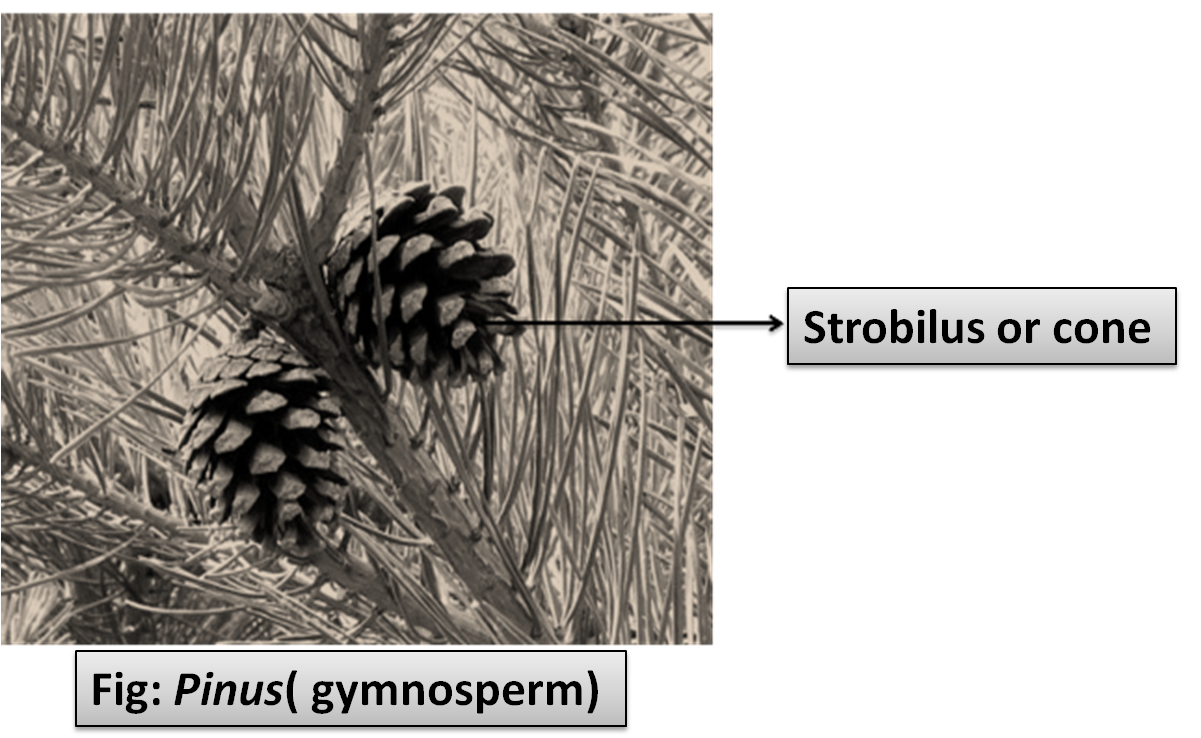Answer
425.1k+ views
Hint: A cone is an organ on a plant that belongs to the division Pinophyta or conifers that contains the reproductive structures. The familiar woody cone is the female cone that produces seeds and is woody in nature.
Complete answer:
In the female cone of pinus, bract scales and ovuliferous scales are present, it carries two sessile ovules at the basis of each ovuliferous scale. The ovuliferous scale is woody and it has two sessile ovules on the upper surface. A cone is the part of the reproductive organ in plants belonging to the division Pinophyta or conifers.
Male cones bear pollen are covered with many fertile scales, each of which bears two pollen sacs. Whereas female cones bear ovules, borne on the same tree, consists of several spirally arranged bracts which are modified leaves. Each bract is located below a scale with two ovules called potential seeds. In spring or early summer, the pollen sacs release pollen through longitudinal slits that reach the ovules through wind and fertilization takes place.

So, the correct answer is,'There are two sessile ovules at the basis of each ovuliferous scale.'
Note: -The name "cone" is derived from the fact that the shape in some species resembles a geometric cone. The individual plates of a cone are called scales.
-The female cone/megastrobilus/seed cone/ ovulate cone contains ovules. On fertilization by pollen, ovules become seeds.
-The female cone structure is more markedly different between the different conifer families and is often crucial for the identification of many species of conifers.
Complete answer:
In the female cone of pinus, bract scales and ovuliferous scales are present, it carries two sessile ovules at the basis of each ovuliferous scale. The ovuliferous scale is woody and it has two sessile ovules on the upper surface. A cone is the part of the reproductive organ in plants belonging to the division Pinophyta or conifers.
Male cones bear pollen are covered with many fertile scales, each of which bears two pollen sacs. Whereas female cones bear ovules, borne on the same tree, consists of several spirally arranged bracts which are modified leaves. Each bract is located below a scale with two ovules called potential seeds. In spring or early summer, the pollen sacs release pollen through longitudinal slits that reach the ovules through wind and fertilization takes place.

So, the correct answer is,'There are two sessile ovules at the basis of each ovuliferous scale.'
Note: -The name "cone" is derived from the fact that the shape in some species resembles a geometric cone. The individual plates of a cone are called scales.
-The female cone/megastrobilus/seed cone/ ovulate cone contains ovules. On fertilization by pollen, ovules become seeds.
-The female cone structure is more markedly different between the different conifer families and is often crucial for the identification of many species of conifers.
Recently Updated Pages
How many sigma and pi bonds are present in HCequiv class 11 chemistry CBSE

Why Are Noble Gases NonReactive class 11 chemistry CBSE

Let X and Y be the sets of all positive divisors of class 11 maths CBSE

Let x and y be 2 real numbers which satisfy the equations class 11 maths CBSE

Let x 4log 2sqrt 9k 1 + 7 and y dfrac132log 2sqrt5 class 11 maths CBSE

Let x22ax+b20 and x22bx+a20 be two equations Then the class 11 maths CBSE

Trending doubts
Fill the blanks with the suitable prepositions 1 The class 9 english CBSE

At which age domestication of animals started A Neolithic class 11 social science CBSE

Which are the Top 10 Largest Countries of the World?

Give 10 examples for herbs , shrubs , climbers , creepers

Difference between Prokaryotic cell and Eukaryotic class 11 biology CBSE

Difference Between Plant Cell and Animal Cell

Write a letter to the principal requesting him to grant class 10 english CBSE

Change the following sentences into negative and interrogative class 10 english CBSE

Fill in the blanks A 1 lakh ten thousand B 1 million class 9 maths CBSE



